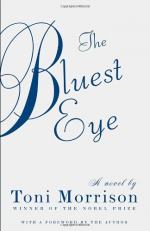|
This section contains 6,085 words (approx. 21 pages at 300 words per page) |

|
SOURCE: Miner, Madonne M. “Lady No Longer Sings the Blues: Rape, Madness, and Silence in The Bluest Eye.” In Conjuring: Black Women, Fiction, and Literary Tradition, edited by Marjorie Pryse and Hortense J. Spillers, pp. 176-91. Bloomington: Indiana University Press, 1985.
In the following essay, Miner links oral storytelling traditions to the process of self-definition in The Bluest Eye, exploring the intersections between Pecola's narrative and mythic accounts of Greek goddesses Philomena and Persephone.
Robert Stepto begins a recent interview with Toni Morrison by commenting on the “extraordinary sense of place” in her novels. He notes that she creates specific geographical landscapes with street addresses, dates, and other such details.1 His observations certainly hold true for Morrison's first novel, The Bluest Eye, set in a black neighborhood in Lorain, Ohio, in 1941. Reading The Bluest Eye, I feel as if I have been in the abandoned store on the southeast...
|
This section contains 6,085 words (approx. 21 pages at 300 words per page) |

|


